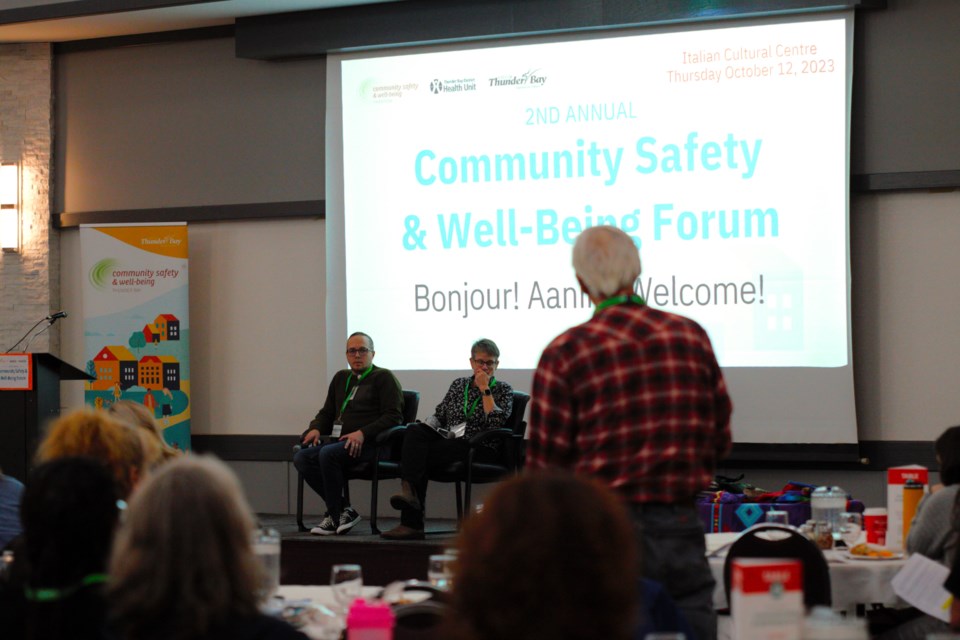THUNDER BAY — A community forum put the spotlight on experiences of childhood trauma Thursday, suggesting more investments in childcare and child and family support services could pay big dividends.
Around 130 people attended the second annual Community Safety & Well-Being Forum held at the Italian Cultural Centre on Thursday.
The day-long event aimed to advance goals in the city’s community safety and well-being plan, with a heavy focus on the impact of childhood experiences.
Council approved the provincially-mandated plan in 2021, setting goals like building a mental health and addictions crisis centre, decreasing incidents of racism, reducing Indigenous homelessness by 50 per cent by 2027, and boosting supportive housing.
Municipal leaders have argued the province is not providing adequate funding for municipalities to achieve those goals, however.
On Thursday, public health and social service leaders argued “adverse childhood experiences” play an outsized role in contributing to poor health outcomes and social challenges.
They also agreed governments and other agencies aren’t acting enough on that knowledge, saying more “upstream” investments in supports for vulnerable children could avert a large degree of suffering, and much larger investments down the line.
“What I was trying to talk about is how we as providers and as governments… don't create our services founded on those important principles as well as we could,” said Children’s Centre Thunder Bay CEO Diane Walker, who led a keynote discussion with Lakehead University Psychology professor Christopher Mushquash.
“My example was childcare — there's a three-year waitlist for childcare, that [early childhood educators] are the most poorly paid professionals.”
“We really need to think about childcare as a protective factor, not a babysitting service. Good childcare also involves a family — it can have food programs, it can have an ability to identify early if there's learning difficulties or disabilities.”
Adverse childhood experiences include experiences like neglect, childhood abuse, losing a parent or close family member, witnessing violence in the home, or having a parent struggling with addiction.
A review by Ontario Public Health found adults who experienced adverse childhood experiences are more likely to report mental health conditions, cardiovascular disease, diabetes and many other chronic conditions.
“There is evidence to suggest that the increased risk for these diseases may be due to physiological changes during childhood as a result of toxic stress response,” the review states.
Research suggests adults who experienced four or more adverse childhood experiences are 12 times more to experience health risks like alcoholism, drug use, depression, and suicide attempts.
“When [researchers] first looked at this, they just discovered that adverse childhood experiences impact all areas of physical and mental health,” said Marianne Stewart, manager of family and school health at the Thunder Bay District Health Unit.
On Thursday, attendees participated in a “brain architecture game” meant to help understand the neurological impacts of traumatic childhood experiences.
Lee-Ann Chevrette, the city’s community safety and well-being specialist, said a full understanding of those facts has deep implications.
“I believe this really kind of grounds the understanding that early childhood experiences, trauma specifically and adversity, actually change the physical architecture of the brain, and that can lead to life-long negative outcomes,” she said.
“I think there really needs to be a paradigm shift away from looking at people in our community who might be struggling and saying, ‘What's wrong with you?’ to, ‘What happened to you?’”
“I don't think we're doing a great job at doing that,” she added. “I believe that's in part why we have to continue to be so reactive in our community, because we haven't done a great job of prevention.”
Chevrette emphasized that adverse childhood experiences are common — it’s estimated more than half of people have experienced at least one — and they don’t define those who do.
“There is hope, and we don't want to make people believe that if someone experiences adversity, they're doomed to poor outcomes — that isn't the case,” she said. “But we need to make people aware that there are things we can do to buffer against that adversity and to help mitigate the impacts.”
Stewart called investing in work to prevent and mitigate childhood trauma one of the best ways to make positive change in the community.
“I talk a lot about environment, creating those supportive environments and making those investments upstream — then you'll prevent people from having ACEs,” she said.
She added that opening remarks by elder Ron Linklater had driven home that fostering healthy relationships with the land and natural world can also be an important protective factor.
